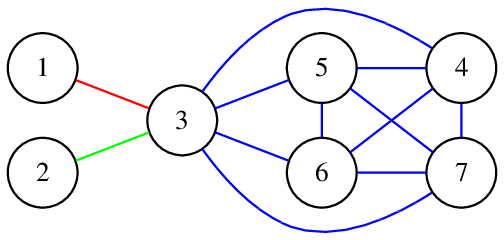CF1408E.Avoid Rainbow Cycles
普及/提高-
通过率:0%
AC君温馨提醒
该题目为【codeforces】题库的题目,您提交的代码将被提交至codeforces进行远程评测,并由ACGO抓取测评结果后进行展示。由于远程测评的测评机由其他平台提供,我们无法保证该服务的稳定性,若提交后无反应,请等待一段时间后再进行重试。
题目描述
You are given m sets of integers A1,A2,…,Am ; elements of these sets are integers between 1 and n , inclusive.
There are two arrays of positive integers a1,a2,…,am and b1,b2,…,bn .
In one operation you can delete an element j from the set Ai and pay ai+bj coins for that.
You can make several (maybe none) operations (some sets can become empty).
After that, you will make an edge-colored undirected graph consisting of n vertices. For each set Ai you will add an edge (x,y) with color i for all x,y∈Ai and x<y . Some pairs of vertices can be connected with more than one edge, but such edges have different colors.
You call a cycle i1→e1→i2→e2→…→ik→ek→i1 ( ej is some edge connecting vertices ij and ij+1 in this graph) rainbow if all edges on it have different colors.
Find the minimum number of coins you should pay to get a graph without rainbow cycles.
输入格式
The first line contains two integers m and n ( 1≤m,n≤105 ), the number of sets and the number of vertices in the graph.
The second line contains m integers a1,a2,…,am ( 1≤ai≤109 ).
The third line contains n integers b1,b2,…,bn ( 1≤bi≤109 ).
In the each of the next of m lines there are descriptions of sets. In the i -th line the first integer si ( 1≤si≤n ) is equal to the size of Ai . Then si integers follow: the elements of the set Ai . These integers are from 1 to n and distinct.
It is guaranteed that the sum of si for all 1≤i≤m does not exceed 2⋅105 .
输出格式
Print one integer: the minimum number of coins you should pay for operations to avoid rainbow cycles in the obtained graph.
输入输出样例
输入#1
3 2 1 2 3 4 5 2 1 2 2 1 2 2 1 2
输出#1
11
输入#2
7 8 3 6 7 9 10 7 239 8 1 9 7 10 2 6 239 3 2 1 3 2 4 1 3 1 3 7 2 4 3 5 3 4 5 6 7 2 5 7 1 8
输出#2
66
说明/提示
In the first test, you can make such operations:
- Delete element 1 from set 1 . You should pay a1+b1=5 coins for that.
- Delete element 1 from set 2 . You should pay a2+b1=6 coins for that.
You pay 11 coins in total. After these operations, the first and the second sets will be equal to {2} and the third set will be equal to {1,2} .
So, the graph will consist of one edge (1,2) of color 3 .
In the second test, you can make such operations:
- Delete element 1 from set 1 . You should pay a1+b1=11 coins for that.
- Delete element 4 from set 2 . You should pay a2+b4=13 coins for that.
- Delete element 7 from set 3 . You should pay a3+b7=13 coins for that.
- Delete element 4 from set 4 . You should pay a4+b4=16 coins for that.
- Delete element 7 from set 6 . You should pay a6+b7=13 coins for that.
You pay 66 coins in total.
After these operations, the sets will be:
- {2,3} ;
- {1} ;
- {1,3} ;
- {3} ;
- {3,4,5,6,7} ;
- {5} ;
- {8} .
We will get the graph:

There are no rainbow cycles in it.